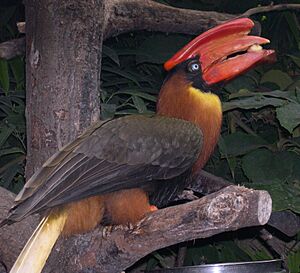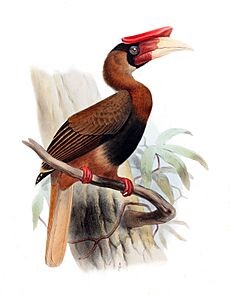Rufous hornbill facts for kids
Quick facts for kids Rufous hornbill |
|
|---|---|
 |
|
| Buceros h. hydrocorax | |
| Conservation status | |
| Scientific classification | |
| Genus: |
Buceros
|
| Species: |
hydrocorax
|
| Synonyms | |
|
|
The rufous hornbill (Buceros hydrocorax) is a very large bird found only in the Philippines. People there also call it the Philippine hornbill or kalaw (say "KAH-lau"). It's the biggest hornbill in the country!
Locals sometimes call this bird the "clock-of-the-mountains." This is because its loud, booming call sounds like it happens every hour. Rufous hornbills live in moist tropical lowland forests. Sadly, these amazing birds are now considered a threatened species. They are losing their homes and are sometimes caught illegally.
It is against the law in the Philippines to hunt, catch, or own rufous hornbills. This is under Philippine Law RA 9147.
Contents
Where Do Rufous Hornbills Live?
The rufous hornbill lives only in the Philippines. You can find them in old, untouched forests, or even in forests that have been disturbed. They live on 11 different islands.
The color of their beak can be different depending on where they live. Some have an all-red beak. Others have a pale yellow color on the front half of their beak.
Different Types of Rufous Hornbills
Scientists recognize three main types, or subspecies, of the rufous hornbill:
- Buceros hydrocorax hydrocorax: This type lives on Luzon and used to live on Marinduque. It is larger and has an all-red beak. It also has a big casque (the horn-like part on top of its beak). Sadly, it is no longer found on Marinduque.
- Buceros hydrocorax semigaelatus: You can find this type on islands like Samar, Leyte, Bohol, and others. It has a yellow front half on its beak. Its casque is smaller and flatter.
- Buceros hydrocorax mindanensis: This type lives on Dinagat, Siargao, Mindanao, and Basilan. It also has a yellow front half on its beak. This type has a large casque.
Some bird experts now think these might be two different species. They call them the Northern Rufous Hornbill and the Southern Rufous Hornbill.
How Rufous Hornbills Behave
As mentioned, people sometimes call this bird "the clock of the mountains." This is because of its regular calls around noon. The powerful Philippine eagle has been known to hunt rufous hornbills.
Reproduction and Life Cycle
Female hornbills are very special when they lay eggs. They seal themselves inside a tree hole or cavity. They stay there with their young ones for most of the nesting time. The male hornbill helps seal the nest from the outside.
The male brings food to the female and the baby birds through a small slit in the sealed nest. Sometimes, other male hornbills that are not breeding also help. Nesting can last for about 4 to 6 months. During this time, the male works hard to feed his family. Rufous hornbills often stay with the same partner for many years.
What Rufous Hornbills Eat
Rufous hornbills are very important for their forest home. They eat both fruits and insects. When they eat fruit, they help spread seeds around the forest. This helps new plants grow. They also eat insects, which helps control insect populations. Because of these habits, they are called a "keystone species." This means they play a vital role in keeping their ecosystem healthy.
Where They Live and How We Protect Them
These birds mostly live in old evergreen forests. They can also live in forests that have been regrowing. The Northern rufous hornbill has been seen up to 760 meters high in Luzon. The Southern rufous hornbill has been seen even higher, up to 2,100 meters, on Mt. Apo.
The rufous hornbill is classified as a vulnerable animal. This means it is at risk of becoming endangered. The Northern Rufous Hornbill is thought to be in more danger. It is listed as Endangered in the Philippines. The Southern type is listed as Vulnerable.
These birds face many threats. Their forest homes are being cut down for farming and wood. This means they lose places to live and find food. They also lose suitable trees for nesting. People sometimes catch these birds for illegal reasons. This includes climbing up nesting trees to take the mother and her chicks.
In some areas, the rufous hornbill has disappeared completely. For example, they are no longer found in Cavite in Mt. Palay-palay. This was due to habitat loss and other human activities.



